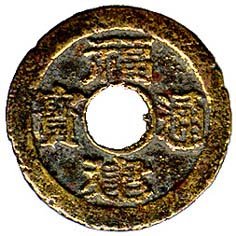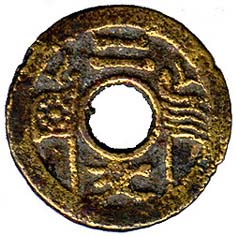| It was about 15 years ago, one day afternoon, a colleaque told me that a hawker who sold coins on the bridge. The bridge was built between the Hong Kong Polytechnic and the Kowloon Railway Station. Everyday, we must walk across the bridge to go to Hunghom to have our lunch. I went to the bridge and met a young man who sold stone engraving and some Chinese ornaments. He came biannually from Foochow of Fukien Province. He had a packet of ancient copper cash. I searched his coins, and found that most of his coins were counterfeit. It is very easy to find out, because his fake coins were engraved directly by pieces of brass. It is unbelievable that his fake cash are "Ch'ien Lung T'ung Pao" or "Dao Kuang T'ung Pao" of Qing Dynasty. [It is common indeed!] Of course, he had some genuine "Wu-shu" coins of Han Dynasty and "An Fa Yuan Pao" or "Ching Hsing T'ung Pao" of Annam. He sold his coin for HK$30 each. [It is unreasonably expensive.]
I was not expecting to find out that there were 6 pieces of "Fu Kien T'ung Pao" cash mixed up with other coins. I recognized that type of coins, but I had never seen them before. I had started to collect copper cash for about 2 years at that time. (I only collected machine-made coins before.) I wandered whether these coins are genuine or not, but it should be worth more than HK$30 each, if they are genuine. The young man found that I was attracted by the "Fu Kien T'ung Pao", he said if I really wanted to buy the coins, he could give me a 30% discount. So that, I had chosen 5 pieces Fukien old cash for HK$100. [about US$12.8]
After I had bought the Fukien old cash, I brought the coins to meet an old coin hawker in Shamshuipo on the following Saturday. I showed him my old cash. He looked at the coins, and said that I knew that kind of coin, but your coins are counterfeit. Oh! I had paid school fee again in my study of Chinese numismatics. I was much disappointed. The old hawker did not tell me why he believed my coins are fake, though I thought I am quite familiar with him.
I thought, I should show my coins to two or more dealers or collectors. But I don't know any other collectors of the old copper cash in Hong Kong. I decided to go to Homongkok Shopping Centre in Mongkok. There were about 30 or more coin shops located in Homongkok Centre at that period, but only a few of the shops selling old Chinese cash. [Hong Kong coin collectors most don't like to collect old Chinese cash, because copper cash are easy in imitation. Collectors of Chinese cash need to read more reference books. But time is very important to them in a modern commercial city like Hong Kong. The chances to view the collections of other collectors are limited in Hong Kong. Hong Kong collectors like to collect modern machine-made coins and bank notes, such as dragon silver coins and Hong Kong old currency.]
I didn't query about the authenticity of my cash to the dealers, instead I asked if I sold the coins to them in the coin shops. Most dealers moved their heads and said : 'no!'. A kind dealer offered to help me and told me that my coins were not the currency of the Republic, but were charms. He turned the coins and explained to me the paterns inscribed on the reverse enthusiastically. [seldom Chinese collectors collect charms.] I was much distressed to hear that I was cheated by someone. Luckily an old dealers promised to buy my coins with HK$30 each as I just wanted to leave. He laughed till his eyes are dim. This enriched my confidence much. Normally, the dealers would pay only half of the coin value. This proved that my old cash was worth at least HK$60 each, if they are authentic. I didn't want to sell my coins, though I could get a profit of HK$50. I knew that my coins are not so common. If I sold them, I might never meet them again.
I thought there is still a hope that my coins may be genuine, I need to catch the chance to prove it, today. I went to Upper Lascar Row on Hong Kong Island. There were normally groups of coin collectors gethering together in the street on every Saturday afternoon before. Some coin hawkers sold coins in the street. I offered my old cash to an antique pedlar for HK$200, he held my old cash for quite a moment, and hesitated what to do next. He made a murmur and wanted to pay HK$180 for my coins. I didn't sell my coins to him and knew that my coins are genuine.
At last, I met Mr. Chang, a famous old hawker about 70 or more at that time. He sold coins in Upper Lascar Row on every Saturday before. As I met him, he was sitting on the stairs surrounding by a group of collectors. When he knew my story, he hold his sides with laughter. He lifted up my coins and explained proudly the mint evolution and the peculiarity of my cash. My affairs were being discussed between each other of the collectors at that moment. Mr. Chang held his audience spellbound with his wealthy knowledge in Chinese numismatics. I became a butt of the collectors.
|

